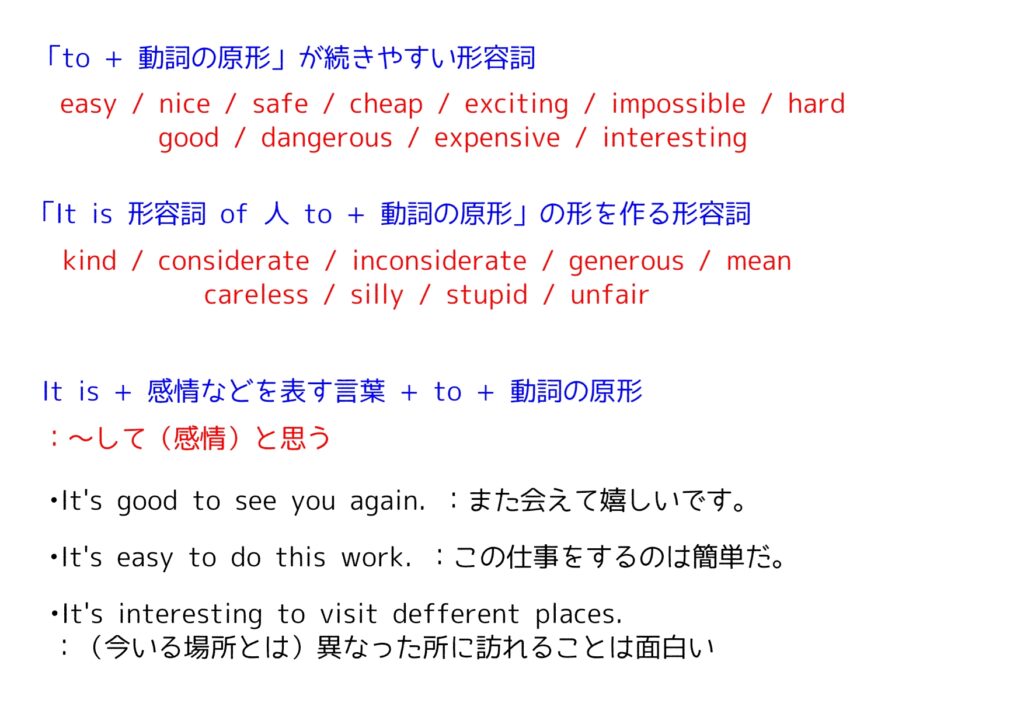第70回:形容詞の後に、具体的な内容を続ける方法。

不定詞を続けたり動名詞を続けたり色々あるので、見てみましょう。
Q. この記事で、一番大事なことって何?
A. 大事なことを、1枚の画像にまとめました。

いちいちノートにまとめるのが面倒だという方、また、
ノートにまとめることが苦手だという方は、ご活用ください。

[広告]
確かな英語力は、日々の継続から。
その継続を後押しする、第二言語習得理論に基づいた
オンライン英語学習プログラムがあります。
英語を使う人のための、確実なスキルアップが望める
7日間の無料体験はこちらから!

形容詞が使われた後の、文の作り方のパターン
今回は、「形容詞 + 不定詞」、「形容詞 + -ing」、「形容詞 + that-clause」、「形容詞 + wh-clause」という文パターンについて解説します。これらの文パターンは、連結動詞(例: appear, be, become, seemなど)の後に形容詞が続く場合に使用されます。
- 形容詞 + to-infinitive
連結動詞の後に形容詞が続き、「不定詞」が続くパターンです。
例えば、「You’re free to leave at any time.」(いつでも帰っても構いません。)という文では、形容詞「free」の後に「to leave」が続いています。同様に、「(un)able, careful, crazy, curious, difficult, easy, foolish, free, good, hard, impossible, inclined, mad」などの形容詞がこのパターンで使用されます。
- 形容詞 + -ing
連結動詞の後に形容詞が続き、「-ing」が続くパターンです。
例えば、「He was busy doing his homework.」(彼は宿題をするのに忙しかった。)という文では、形容詞「busy」の後に「doing his homework」が続いています。「nice, prepared, ready, stupid, welcome, willing busy, crazy, foolish, mad」などの形容詞がこのパターンで使用されます。また、「feel」の後に使用される場合は、「awful, awkward, bad, good, guilty, terrible」などがあります。
- 形容詞 + that-clause
連結動詞の後に形容詞が続き、「that-clause」が続くパターンです。
例えば、「He became worried (that) she might fall down.」(彼は彼女が倒れるかもしれないと心配になった。)という文では、形容詞「worried」の後に「that she might fall down」が続いています。「afraid, alarmed, amazed, angry, annoyed, ashamed, astonished, aware, concerned, disappointed, glad, (un)happy, pleased, shocked, sorry, upset, worried」などの形容詞がこのパターンで使用されます。また、「certain, confident, positive, sure」も同様に使用されます。
- 形容詞 + wh-clause
連結動詞の後に形容詞が続き、「wh-clause」が続くパターンです。
例えば、「I’m not certain (of/about) why he wants to borrow the money.」(彼がなぜお金を借りたいのかはわかりません。)という文では、形容詞「certain」の後に「why he wants to borrow the money」が続いています。「afraid, not aware/unaware, not certain/uncertain, doubtful, not sure/unsure, worried」などの形容詞がこのパターンで使用されます。
- It + linking verb + adjective
主語が「it」で連結動詞の後に形容詞が続くパターンです。このパターンでは、主語が先行しているため、後続の「to-infinitive」や「wh-clause」が副詞的に使われます。
例えば、「The fireworks were amazing to watch.」(花火は見る価値があるものだった。)という文では、「It was amazing to watch the fireworks.」とも表現できます。「annoying, awkward, easy, good, interesting, lovely, simple, terrific, wonderful」などの形容詞がこのパターンで使用されます。
また、口語では「to-infinitive」の代わりに「-ing」形を使用することもあります。「It is easy understanding her.」「It was amazing watching the fireworks.」といった表現が該当します。
- It + make + 形容詞 + to-infinitive, -ing, that-clause
状況に対する反応を表現する際に使用されるパターンです。主語が「it」で連結動詞「make」が続き、その後に形容詞と「to-infinitive」、もしくは「-ing」形や「that-clause」が続きます。
例えば、「It made me angry (to discover) that so much money was wasted.」「It was odd that she left so suddenly.」といった文が該当します。「ashamed, furious, glad, happy, miserable, nervous, sad, tired, uncomfortable」などの形容詞が使用されます。
以上が、形容詞 + to-infinitive, -ing, that-clause, wh-clauseの文パターンについての解説でした。これらの文パターンを活用して、より表現力豊かな文章を作りましょう。
具体例
to-infinitive:
- She was excited to meet her favorite celebrity.
- He was determined to pass the exam.
- They were afraid to ask for help.
-ing:
- It was surprising seeing her at the party.
- I felt guilty eating the last piece of cake.
- We were thrilled watching the sunset.
that-clause:
- He was relieved that he had finished the project on time.
- She was worried that she might miss her flight.
- They were disappointed that the concert was canceled.
wh-clause:
- I’m not sure why he didn’t attend the meeting.
- She was uncertain about what she should wear to the event.
- They were doubtful whether they should invest in the new business.
It + linking verb + adjective:
- The movie was scary to watch. (or It was scary to watch the movie.)
- It is frustrating to deal with technical issues. (or It is frustrating dealing with technical issues.)
- It was confusing that nobody provided any instructions. (or It was confusing that there were no instructions.)
It + linking verb + -ing:
- It is exciting exploring new places.
- It is annoying waiting in long queues.
- It was amazing seeing the dolphins in the ocean.
It + linking verb + that-clause:
- It is surprising that he won the competition.
- It is disappointing that they couldn’t attend the wedding.
- It was odd that she didn’t say goodbye.
Adjective + to-infinitive (with “of + subject”):
- It was thoughtful of them to bring flowers for her.
- It was brave of him to confront the bully.
- It was kind of them to offer their assistance.
It + make + adjective + to-infinitive, -ing, or that-clause:
- It made me happy to receive a compliment. (or It made me happy receiving a compliment.)
- It makes me tired to stay up late. (or It makes me tired staying up late.)
- It made her sad that they couldn’t attend her graduation.
[広告]
TOEICのスコアを上げたいけれど、
まとまった勉強時間が取れなくて困っている…
なら、細かいスキマの時間を使いながら、
少しずつスキルを積み重ねてみてはどうでしょう。
スマホ1つでスコアアップが出来る、
オンライン講座のリンクはこちらから。

Q. この文法はどうやって使うのでしょうか?
A. 今回の文法を活用した会話文を見てみましょう。

I’m really curious to know why Sarah quit her job.
(サラが仕事を辞めた理由が気になるんだよね。)

Well, it seems that she became unhappy with the company’s management.
(まあ、会社の経営方針に不満を抱いたみたいだよ。)

I can understand why she would feel that way. It’s disappointing to work in such a disorganized environment.
(そんな縦割りの環境で働くのはがっかりだよね。)

Exactly. She was tired of dealing with constant chaos and unprofessional behavior.
(まったくその通りだよ。彼女は常に混乱と非専門的な態度にうんざりしていたんだ。)

It’s brave of her to take a stand and leave. I’m sure she’ll find a better opportunity elsewhere.
(辞めるというのは勇気があるよね。他に良い機会を見つけることができると思うよ。)

I’m certain she will. It’s hard to stay in a job where you’re constantly frustrated.
(絶対にね。常にイライラするような職場には長くはいられないよ。)

I’m glad she made the decision to prioritize her well-being. It’s important to be in a work environment that makes you happy.
(彼女が自分の幸福を優先するという決断をしたのは嬉しいな。自分を幸せにする職場にいることは重要だから。)

Absolutely. Being unhappy at work can have a negative impact on your overall quality of life.
(まったくその通り。仕事で不幸な状態が続くと、全体の生活の質に悪影響を及ぼすんだ。)

I couldn’t agree more. It’s crucial to be in a job that aligns with your values and brings you joy.
(本当にその通りだね。自分の価値観に合い、喜びをもたらしてくれる仕事に就くことは重要だよね。)
[広告]
ロゼッタストーン・ラーニングセンターで、最先端の教育制度を活用して英語を学びませんか?私たちは個々の学習ペースに合わせてeラーニングと対面教育を組み合わせ、柔軟な学習環境を提供しています。自宅でのeラーニングと対面教育のメリットを最大限に活かし、あなたの英語学習をサポートします。最新のテクノロジーと個別の指導が組み合わさった当センターで、自由な学習スタイルを体験してみませんか?英語学習を楽しく効果的に進めるための環境がここにあります。新たな一歩を踏み出して、新しい英語学習の旅に参加しましょう!

Q. この記事の要点は?
A. 形容詞の後の文の続け方のパターンを確認しました。
Adjective + to-infinitive, -ing, that-clause, wh-clause:
- When an adjective follows a linking verb, it can be followed by:
- To-infinitive: You’re free to leave at any time.
- -Ing: He was busy doing his homework.
- That-clause: He became worried (that) she might fall down.
- Wh-clause: I’m not certain (of/about) why he wants to borrow the money.
Note: Different adjectives are used in each pattern.
- It + linking verb + adjective:
- It + linking verb + adjective + to-infinitive: It was amazing to watch the fireworks.
- It + linking verb + adjective + -ing (informal speech): It is easy understanding her.
- It + linking verb + adjective + wh- or that-clause: It is not clear why he did it.
- After certain adjectives, we can use of + subject + to-infinitive:
- Rude (of them) to criticize her.
- Adjectives: brave, generous, kind, mean, thoughtful, unprofessional, unreasonable.
- It + make + adjective + to-infinitive, -ing, or that-clause to talk about reactions to a situation:
- It made me angry (to discover) that so much money was wasted.
- Adjectives: ashamed, furious, glad, happy, miserable, nervous, sad, tired, uncomfortable.
英会話を始めてみたいけれど、どのサービスが良いか分からない…
そんな方は、まず、この記事で3つのサービスを比べてみてはいかがでしょうか?
英語力を効率良く伸ばすことができるサービス3選です。

次回の文法解説は?
形容詞と副詞。
この記事を作る際に参考にした文法の解説書になります。
すべて英語で書かれていますが、練習問題が付いてます。
イギリス英語なので、スペル等の表記が異なる部分もありますが、
「使い方を練習したい」「繰り返し問題を解きたい」
という方は、使ってみても良いかもしれません。

関連記事一覧
他の文法解説記事を検索できます。



-320x180.jpg)








コメント